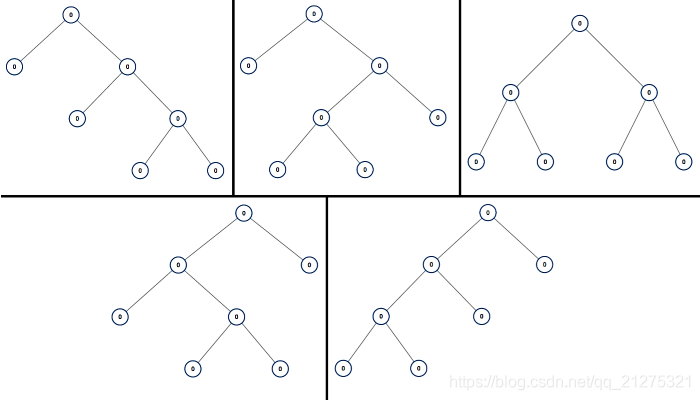版权声明:本文为博主原创文章,未经博主允许不得转载。 https://blog.csdn.net/qq_21275321/article/details/84104450
题目:
A full binary tree is a binary tree where each node has exactly 0 or 2 children.
Return a list of all possible full binary trees withNnodes. Each element of the answer is the rootnodeof one possible tree.
Each node of each tree in the answer must havenode.val = 0.
You may return the final list of trees in any order.
Example 1:
Input: 7 Output: [[0,0,0,null,null,0,0,null,null,0,0],[0,0,0,null,null,0,0,0,0],[0,0,0,0,0,0,0], [0,0,0,0,0,null,null,null,null,0,0],[0,0,0,0,0,null,null,0,0]]Explanation:

Note:
1 <= N <= 20
解释:
返回N个结点能构成的所有的满二叉树的形式。
满二叉树:要求所有的结点都有0个或者2个叶子结点。
完全二叉树:若设二叉树的深度为h,除第 h 层外,其它各层 (1~h-1) 的结点数都达到最大个数,第 h 层所有的结点都连续集中在最左边。
(1)所有的叶结点都出现在第k层或k-l层(层次最大的两层)
(2)对任一结点,如果其右子树的最大层次为L,则其左子树的最大层次为L或L+l。
也就是完全二叉树比满二叉树的形式更加集中。
需要注意的是,如果N是偶数,则一定不能构成满二叉树。
python代码:
# Definition for a binary tree node.
# class TreeNode(object):
# def __init__(self, x):
# self.val = x
# self.left = None
# self.right = None
class Solution(object):
def __init__(self):
#记忆化一下,因为会有很多重复计算
self._dict={1:[TreeNode(0)]}
def allPossibleFBT(self, N):
"""
:type N: int
:rtype: List[TreeNode]
"""
result=[]
#偶数个结点一定无法构成满二叉树。
if N<=0 or N%2==0:
return result
#这里很重要
if N in self._dict:
return self._dict[N];
for l in range(1,N,2):
for left in self.allPossibleFBT(l):
for right in self.allPossibleFBT(N-1-l):
root=TreeNode(0)
root.left=left
root.right=right
result+=[root]
self._dict[N]=result;
return result
c++代码:
/**
* Definition for a binary tree node.
* struct TreeNode {
* int val;
* TreeNode *left;
* TreeNode *right;
* TreeNode(int x) : val(x), left(NULL), right(NULL) {}
* };
*/
#include <map>
using namespace std;
class Solution {
public:
//记忆化
map<int,vector<TreeNode*>>_map;
Solution()
{
TreeNode* tmp=new TreeNode(0);
_map[1]={tmp};
}
vector<TreeNode*> allPossibleFBT(int N) {
vector<TreeNode*>result;
if (N<=0|| N %2==0)
return result;
if (_map.count(N))
{
return _map[N];
}
for (int l=1;l<N;l+=2)
{
vector<TreeNode*> left_list=allPossibleFBT(l);
vector<TreeNode*> right_list=allPossibleFBT(N-1-l);
for (auto left:left_list)
{
for(auto right:right_list)
{
TreeNode* root=new TreeNode(0);
root->left=left;
root->right=right;
result.push_back(root);
}
}
}
_map[N]=result;
return result;
}
};
解释:
对于这种会重复计算的问题,用一个全局的字典记录已经计算好的值可以节省大量的时间。